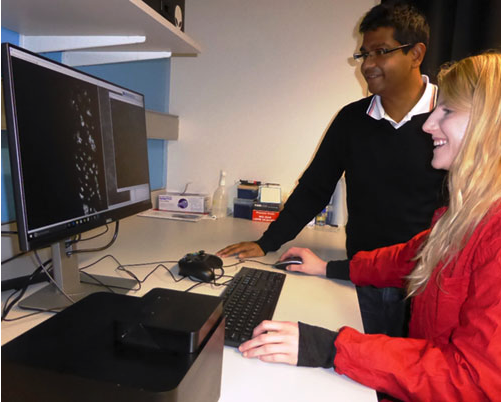Members Login

Channels
Special Offers & Promotions
Oxford Nanoimaging Report on how the Nanoimager, a Desktop Microscope Delivering Single Molecule, Super-Resolution Performance, is Being Applied at the MRC Centre for Molecular Bacteriology & Infection
Oxford Nanoimaging Limited manufacture and sell microscopes offering super-resolution and single-molecule performance to research users.
 Today, the company reports on the work of early-adopters for their Nanoimager technology at the MRC Centre for Molecular Bacteriology and Infection located at Imperial College, London.
Today, the company reports on the work of early-adopters for their Nanoimager technology at the MRC Centre for Molecular Bacteriology and Infection located at Imperial College, London.
The MRC Centre for Molecular Bacteriology and Infection is uniquely focused on disease-causing bacteria. Ramesh Wigneshweraraj is a Professor of Microbiology leading a group that is working at the leading edge of understanding the behaviour of small proteins produced by viruses that infect bacteria (phages) at the single cell level to ultimately inspire and inform the development of truly novel drugs against antibiotic-resistant bacterial pathogens.
Networking in science is so often the provider for new discoveries and collaborations. A meeting at Cambridge proved the point here with Professor Wigneshweraraj (Ramesh) meeting Oxford physicist, Professor Achillefs Kapanidis of the Clarendon Laboratory. Discussing their research over a drink on a warm summer evening, Professor Kapanidis pulled out his laptop and showed results of an experiment very relevant to that being defined by his colleague, Ramesh. One thing led to another and an early demonstration for the Nanoimager, a high resolution single molecule imaging technique developed over a number of years by the Kapanidis group. When, in May 2016, newly-formed company Oxford Nanoimaging (ONI) launched the commercial version of the Nanoimager, Ramesh set out to get funding for the system. With support from the Wellcome Trust, one of ONI's first installations was made at Imperial College in September.
Since its arrival, the Nanoimager has been put through its paces by PhD student, Amy Switzer. Without a background in microscopy, Amy has been able to define what she needs from the instrument to satisfy her research needs. Now working alongside ONI's development team, she is evaluating new data processing software to enable her to produce data at the super-resolution levels. Having a multifunctional system is enabling her to use a variety of imaging methods to achieve live cell imaging at the single molecule level. Techniques at the single molecule level including immunofluorescence, tracking PALM and dSTORM, will now help Amy and Ramesh to work quickly on their goal – the rapid evaluation of how phage-derived small proteins inhibit bacteria and how bacterial enzymes behave in response to the diverse stresses they are subjected to. The Nanoimager, seen below, is a very small unit measuring just 21 cm x 21 cm. It requires no special environmental conditions like an isolation table as it has been designed to compensate for acoustic and vibrational issues. As Amy says, “I am very fortunate to be one of the first users of the Nanoimager. I can work directly with the inventors including Bo Jing from the Kapanidis team. I am able to request new iterations of software and these are delivered with enthusiasm by the ONI folks.”
Timing is very important and here Ramesh takes up the story. “My meeting with Achillefs and the acquisition of the Nanoimager has come at the right time for my research needs. It enables me to understand the behaviour of individual proteins within single bacterial cells. Given the appropriate experimental protocols, I am able to easily detect specific proteins in mixed populations of bacteria. Looking ahead, I can envisage an application of the NanoImager in early diagnostics of bacterial infections, thus enabling rapid species identification and ensuring the correct medication is prescribed, and thereby improving patient welfare while reducing costs. We are really excited to work with ONI in the on-going development of diverse applications for the Nanoimager and, more importantly, to advance fundamental bacteriology in this new and exciting direction.”
Media Partners


